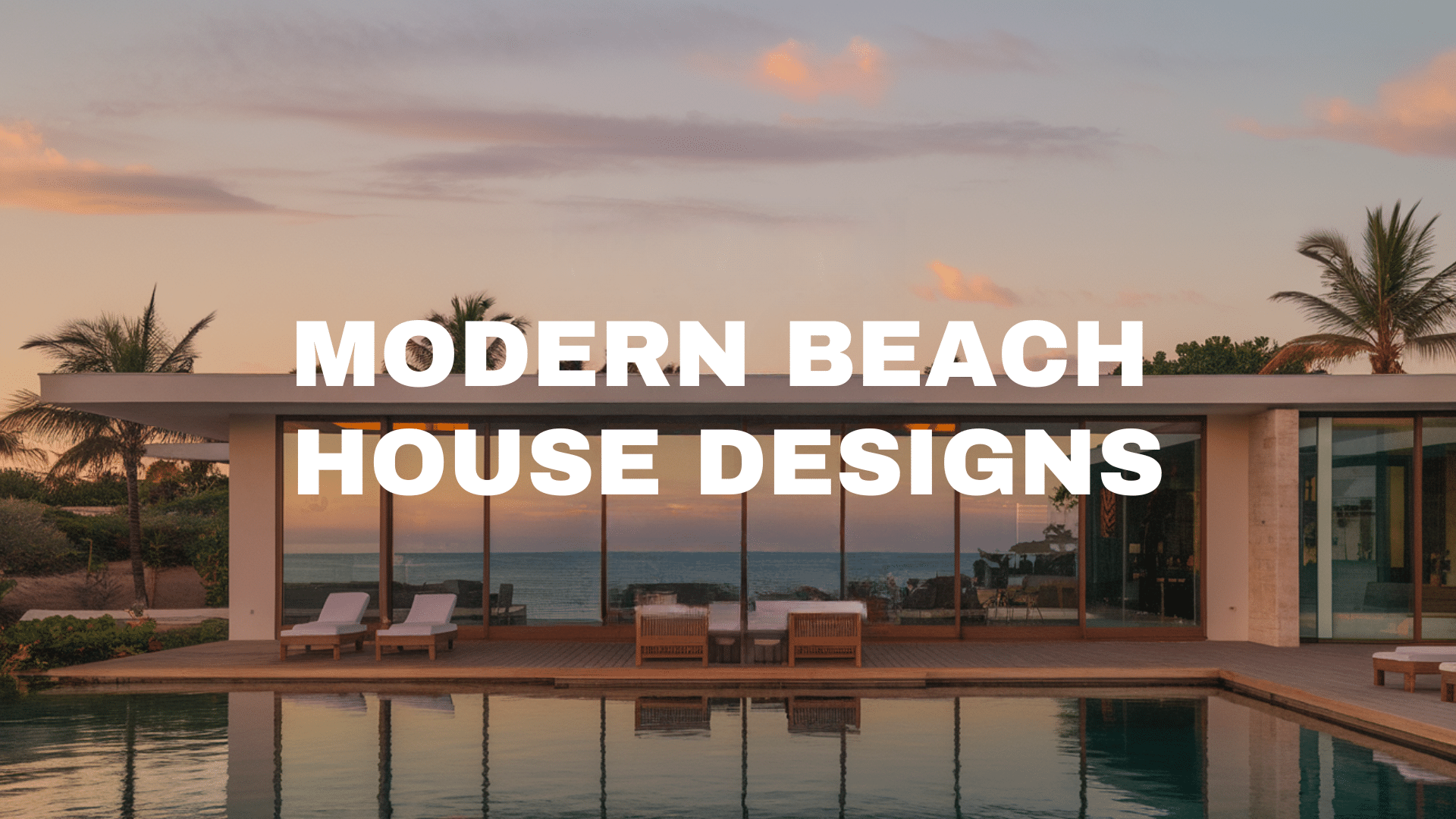Dreaming of a beach house that combines style and coastal living? You’re in the right place. My guide breaks down the important elements that make modern beach homes so special.
I’ll show you exactly how to create that perfect blend of luxury and laid-back beach vibes. From beautiful windows that frame ocean views to smart storage solutions for sandy gear, I’ve covered everything you need.
As someone who’s designed coastal homes for over a decade, I’ve learned what truly works in these unique environments.
Whether you’re building new, renovating, or just dreaming, these design elements will help you create a beach home that’s both beautiful and practical.
Benefits of Modern Beach House Designs
I love how beach houses have changed over the years. They’re not just summer getaways anymore. Today’s beach homes work year-round.
You get so much more than just a pretty view. Modern designs bring in tons of natural light that brightens your mood even on cloudy days.
The indoor-outdoor flow means you can enjoy ocean breezes from almost anywhere in the house.
These homes are built smarter too. Materials that stand up to salt, sand, and storms save you headaches down the road. No more constant repainting or replacing rotted wood!
What really makes me happy is seeing how these designs cut energy costs. Proper orientation and good windows can slash your cooling bills in summer.
And let’s not forget the value factor. A well-designed beach house holds its value better and attracts buyers quickly if you ever decide to sell.
Key Elements that Define Modern Beach House Design
Modern beach homes go beyond just ocean views—they bring the outdoors in, use smart materials, and prioritize breezy, functional style. Below are the essential elements that define this look:
1. Open Concept Layout
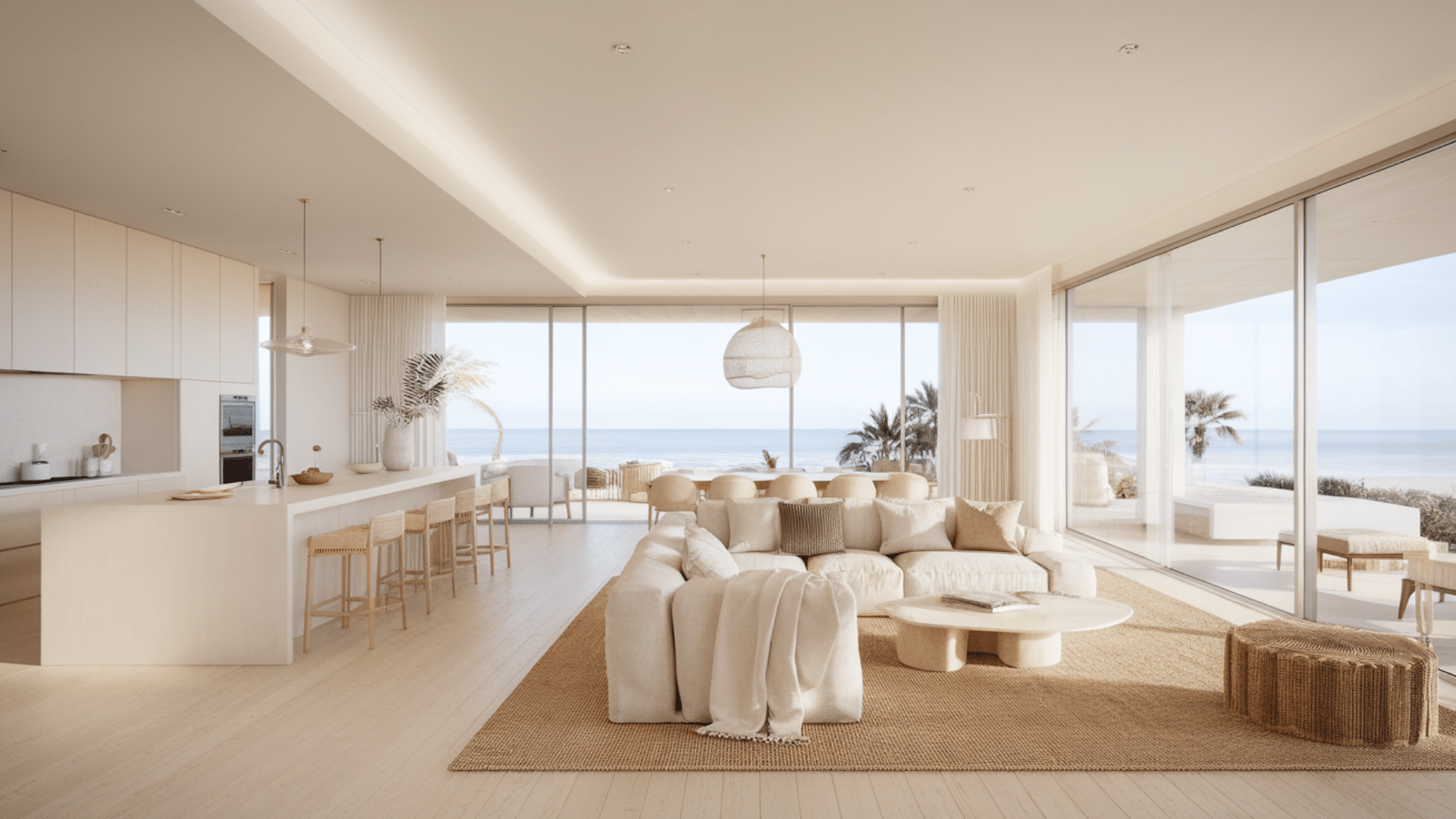
The heart of any modern beach house is its flowing, open design. Walls come down between kitchens, dining areas, and living spaces.
This creates one connected area where family can interact freely. You can cook dinner while watching kids play or chatting with guests.
The open layout also allows ocean views to be enjoyed from multiple spots in the home. Light travels unobstructed through the space, making even smaller beach cottages feel spacious and airy.
When planning your layout, think about sight lines to windows and outdoor spaces. A well-designed open concept should draw your eye naturally to the best views and outdoor access points.
2. Floor-To-Ceiling Windows
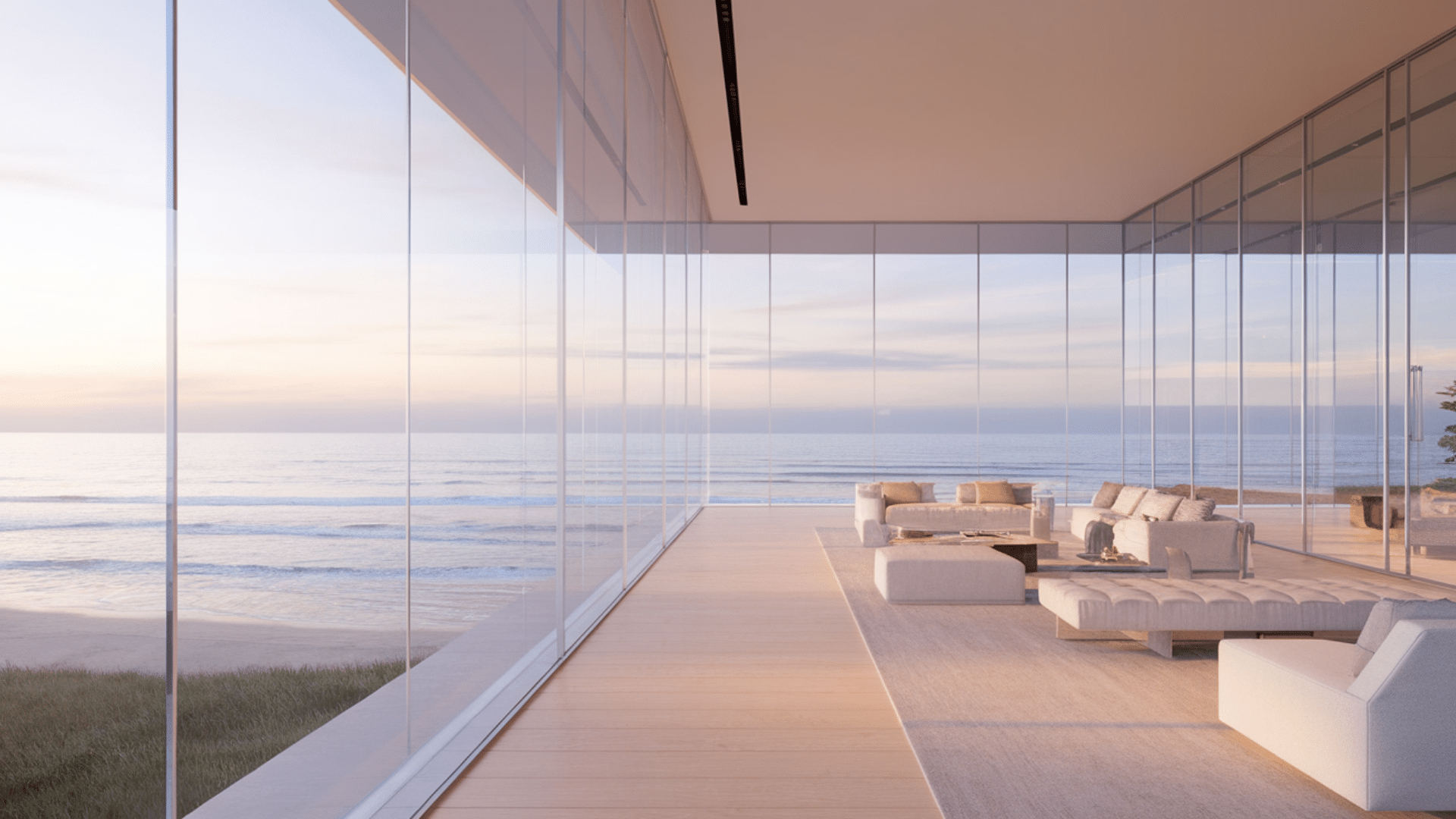
Nothing captures the beach experience like massive windows that frame the coastline.
Floor-to-ceiling glass turns ordinary walls into living paintings of sky, water, and horizon. These dramatic windows bring the outdoors in like nothing else.
The natural light they provide reduces the need for artificial lighting during daytime hours. This saves energy and creates a more natural, uplifting environment.
Modern impact-resistant glass options make these large windows practical even in hurricane-prone areas.
When selecting windows, consider low-E coatings that block UV rays. This protects your furniture from fading while still allowing in that gorgeous natural light.
3. Expansive Decks and Patios
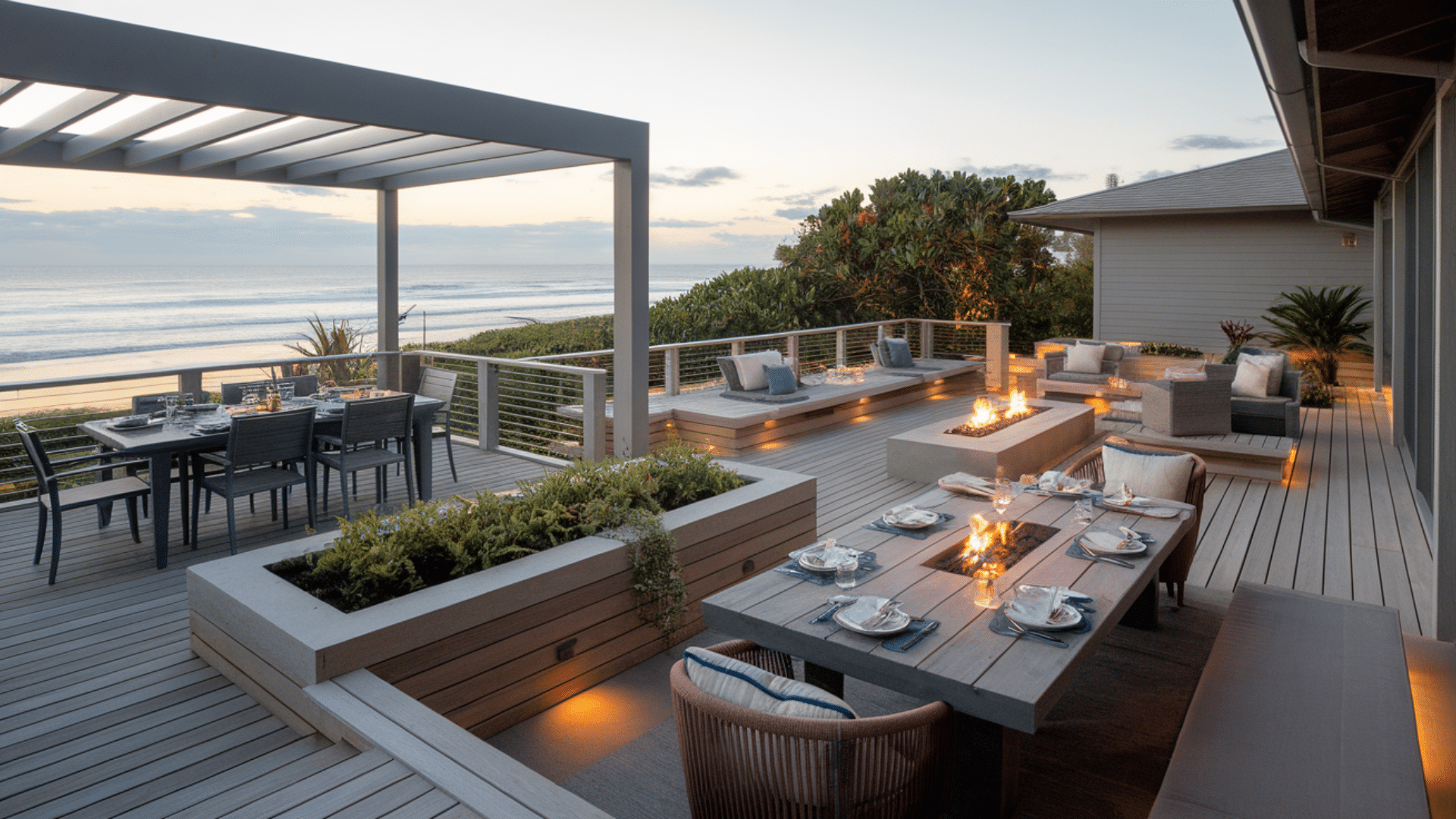
Outdoor living defines the beach house experience. Large decks and patios essentially double your living space when the weather is nice.
These areas become natural gathering spots for meals, conversations, and relaxation. Multi-level decks can create different zones for dining, lounging, and enjoying the view.
Materials matter greatly here—composite decking, tropical hardwoods, or polished concrete all offer durability in harsh coastal environments.
Consider building in features like bench seating or planters to maximize functionality. Adding a pergola or partial roof ensures you can use these spaces even during light rain or intense midday sun.
4. Sustainable Materials
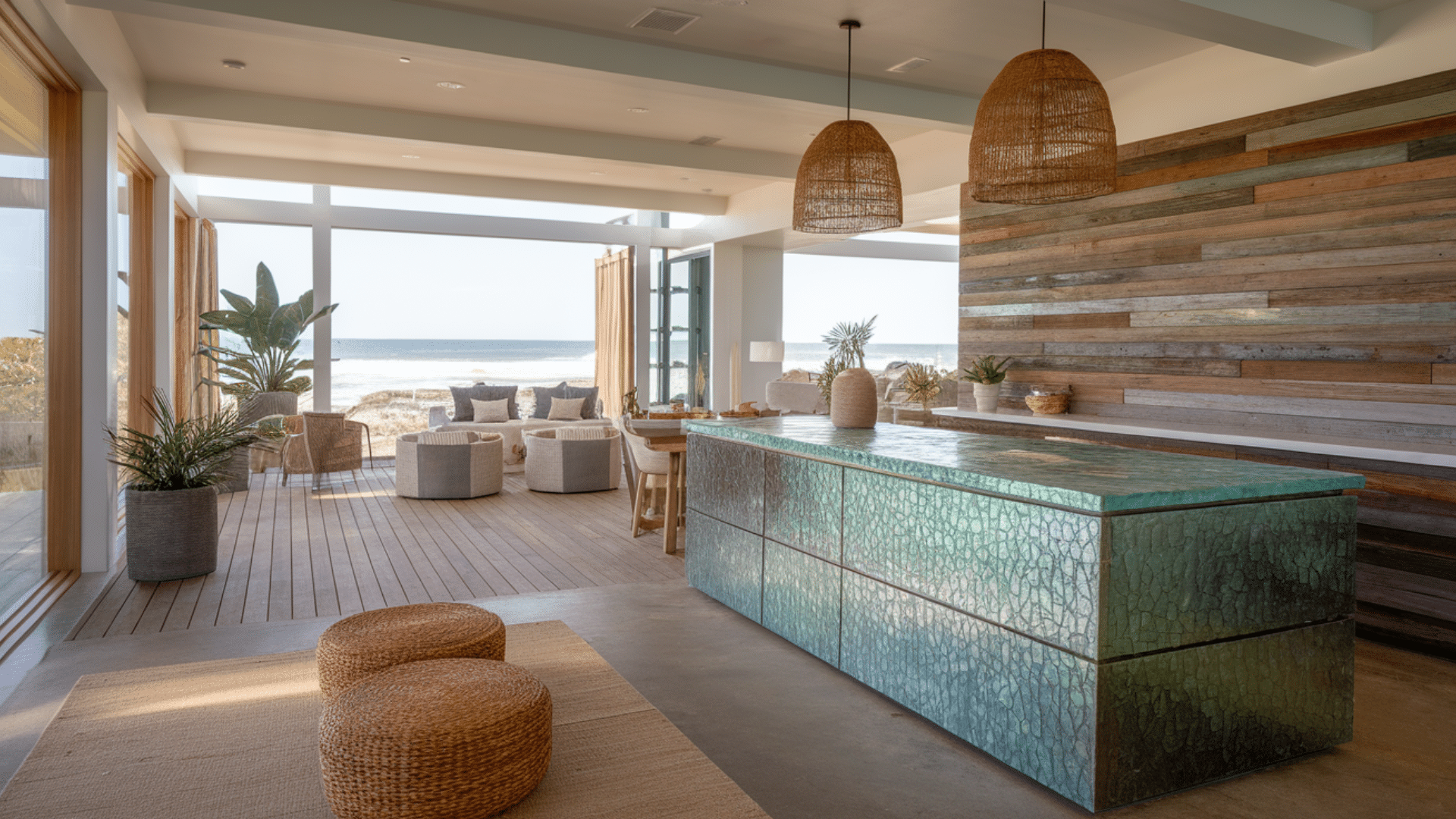
Beach homes connect us with nature, so it makes sense to build them with earth-friendly materials.
Reclaimed wood brings character and history while giving new life to existing resources. Bamboo flooring offers durability from a rapidly renewable source.
Recycled glass countertops sparkle like beach glass and reduce landfill waste. Cork flooring provides a soft, warm surface that’s naturally water-resistant.
These sustainable choices often perform better in coastal environments while reducing your environmental footprint. Look for locally-sourced materials when possible to reduce transportation emissions.
Many sustainable options actually require less maintenance, saving you time and money over the life of your home.
5. Neutral Color Palettes
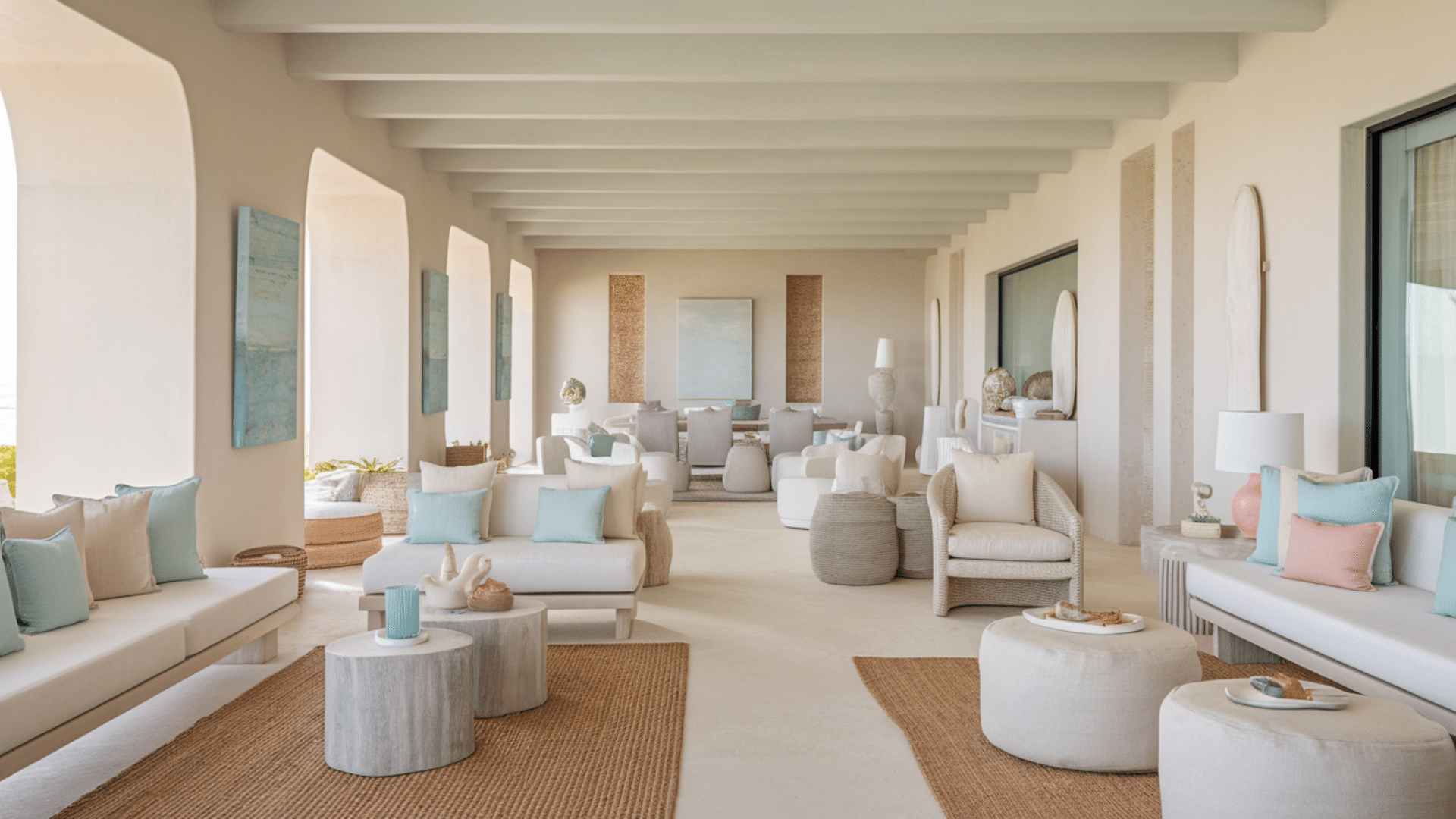
Soft, natural colors create a sense of calm in beach houses. Sandy beiges, crisp whites, and soft grays mimic the colors found along the shoreline.
This neutral backdrop lets the vibrant blues and greens of the ocean view stand out as the real star. Consider slightly warmer whites rather than stark ones for a more inviting feel that still reads as fresh and clean.
These light colors also reflect sunlight, keeping interiors cooler naturally. Accents in sea glass blues or sunset corals can add personality without overwhelming the peaceful vibe.
Even the most minimalist color scheme feels rich when natural textures are incorporated. Paint finishes matter in humid environments—opt for quality paints with mildew resistance.
6. Stilt Foundation
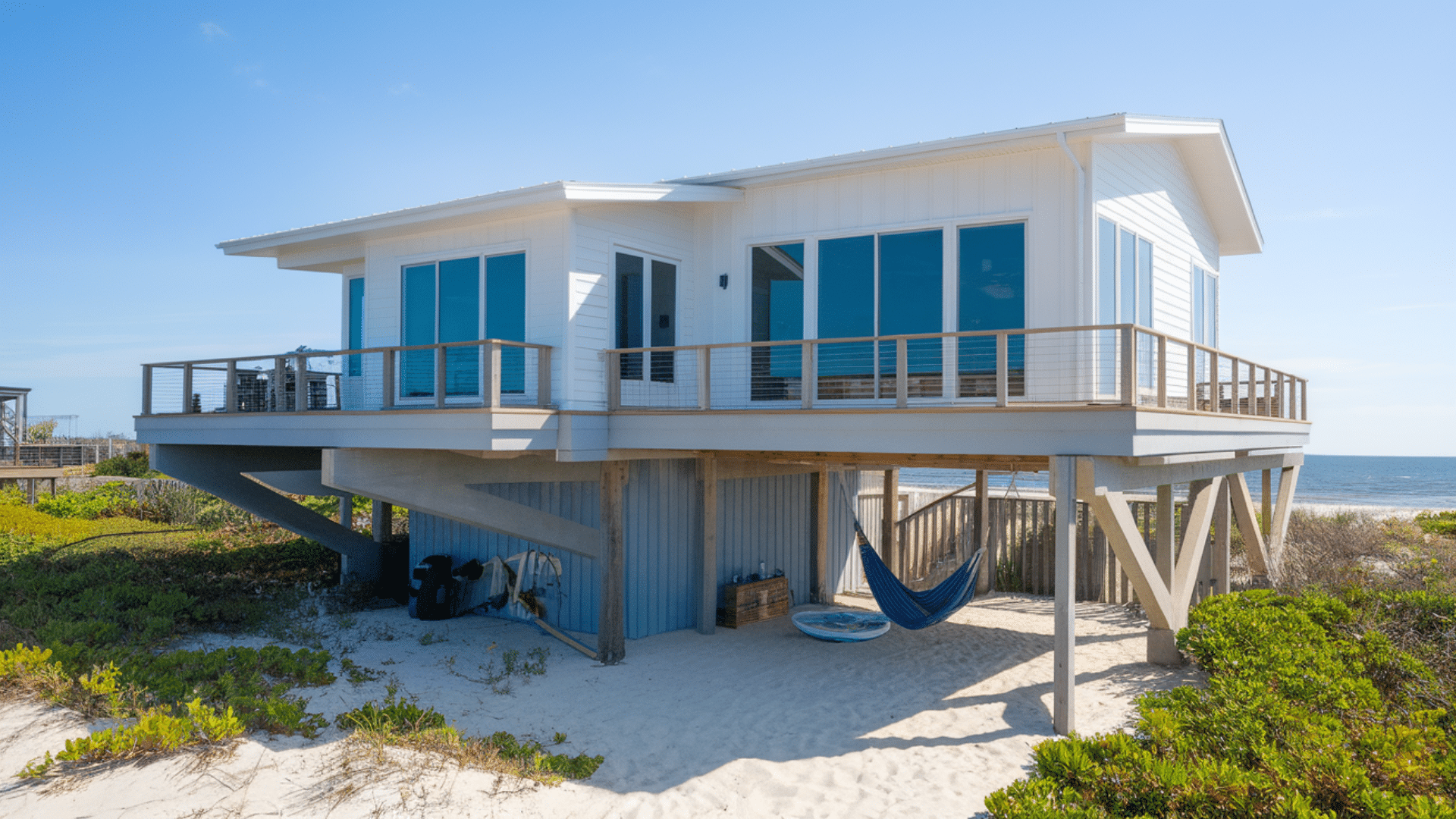
Lifted up beach homes on stilts serves both practical and design purposes. This design approach protects against flooding and storm surges in coastal areas.
It also creates covered parking or storage areas underneath the main living space. The uplifted perspective improves views dramatically, often allowing you to see over dunes or neighboring properties.
The space beneath can become an outdoor shower area, hammock lounge, or place to store kayaks and beach gear. Building codes in many coastal areas now require this type of construction for safety reasons.
Modern stilt designs can be architectural features rather than just functional elements, with attractive materials and thoughtful fusion into the overall design.
7. Flat or Low-Pitched Roofs
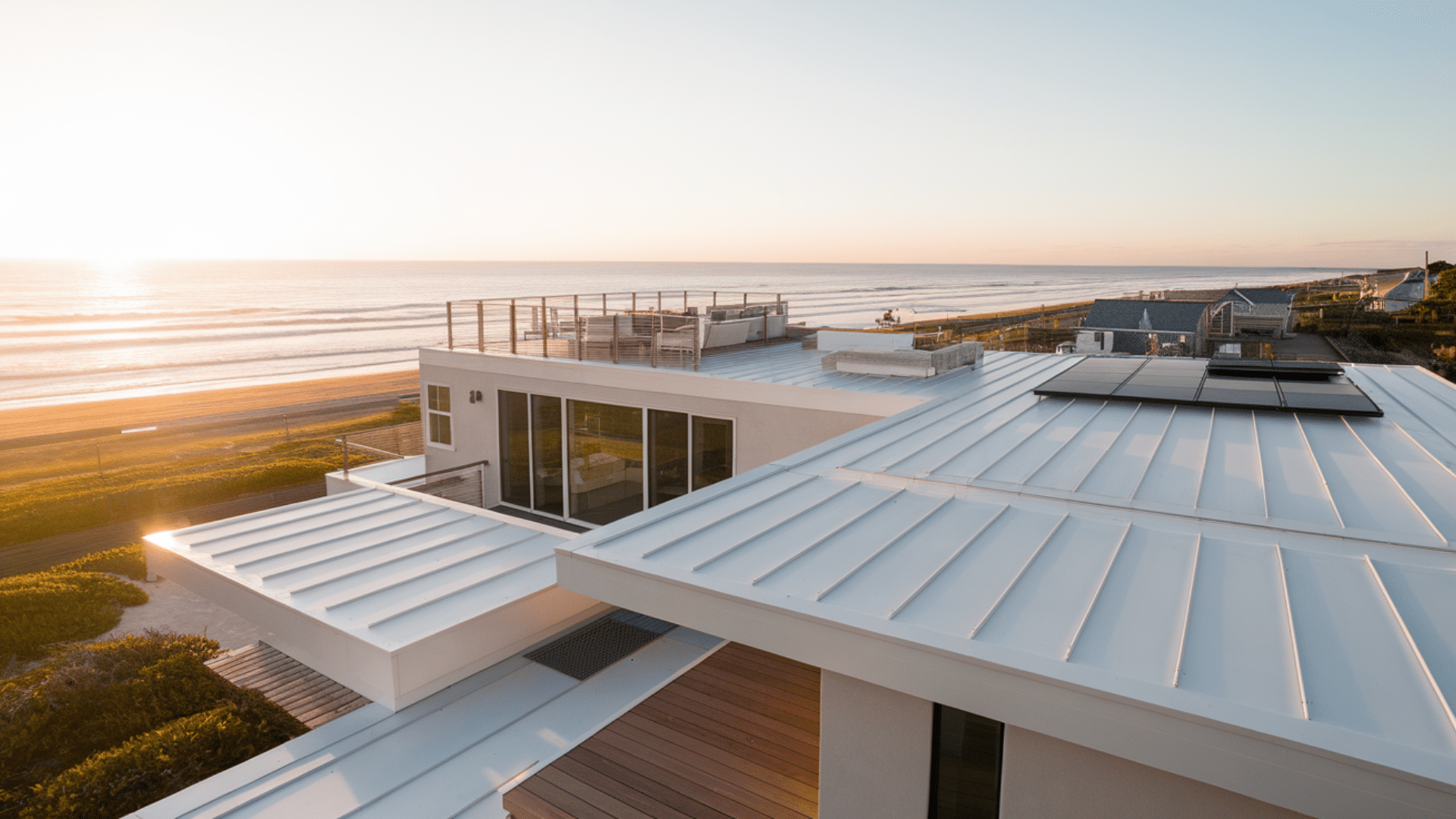
Clean, horizontal roof lines complement the expansiveness of ocean horizons. These roof types are ideal for solar panel installation, making sustainable energy more efficient.
These modern roof designs create a unique silhouette that stands out from traditional peaked-roof houses. The minimal profile resists wind uplift better in coastal storms.
Many designs incorporate partial roof decks for stargazing or sunbathing in private. Overhangs can be calculated precisely to block summer sun while allowing winter warmth.
Materials like standing seam metal offer longevity in salt-air environments. Proper insulation under these roofs is crucial for temperature regulation in beach locations with intense sun exposure.
8. Sliding Glass Doors
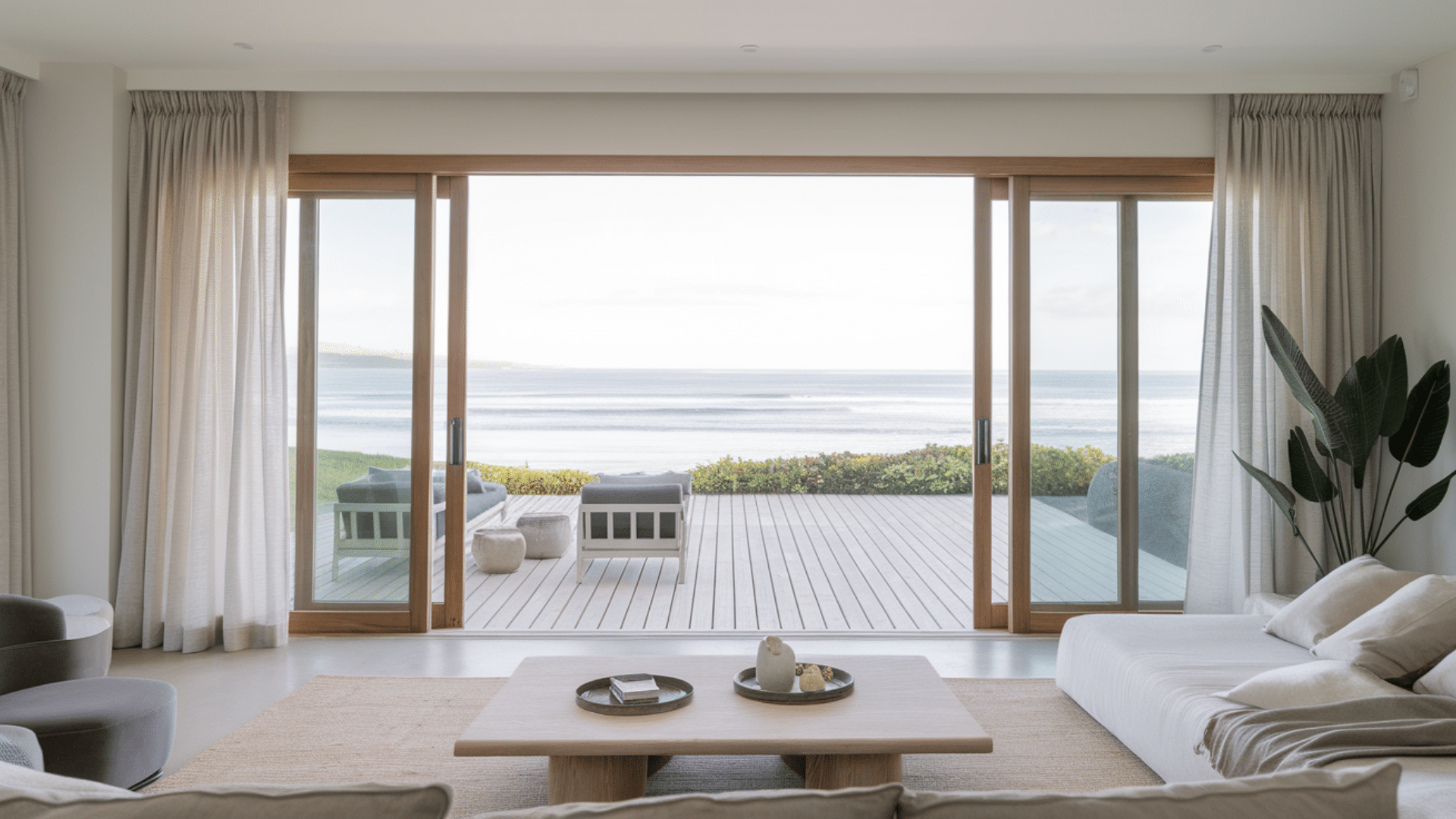
The transition between indoors and outdoors becomes nearly invisible with large sliding glass doors.
Modern systems can span incredible widths, with panels that stack or disappear completely into wall pockets. This creates truly seamless integration with deck or patio spaces.
These doors maximize cross-ventilation on pleasant days, reducing air conditioning needs. Today’s options include lift-and-slide systems that seal tightly when closed for excellent weatherproofing.
Some designs can span an entire wall, turning living rooms into open-air pavilions.
Look for marine-grade hardware that resists corrosion from salt air. Multi-point locking systems provide security without compromising the clean design of large glass panels.
9. Shaded Pergolas and Awnings
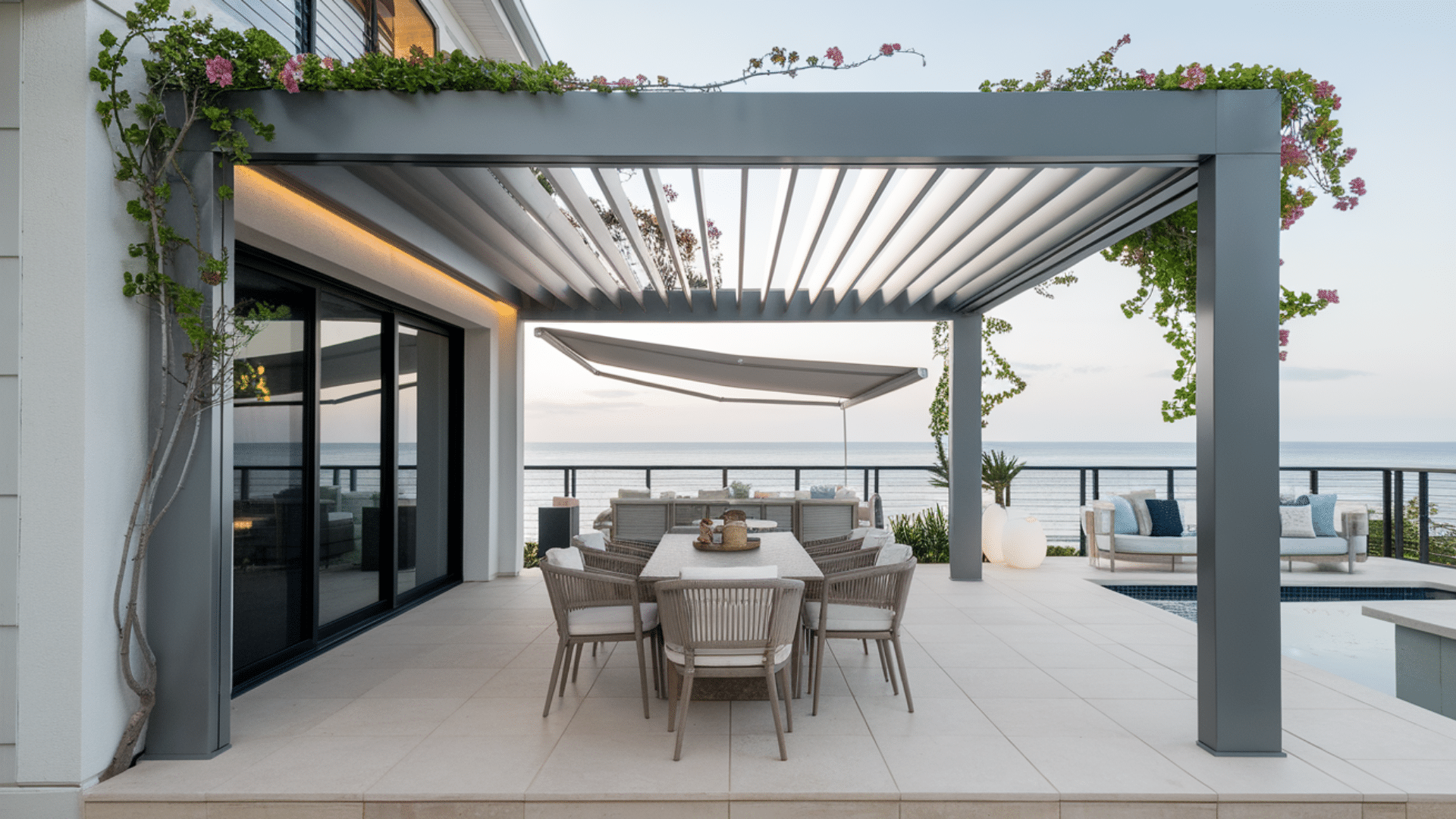
Thoughtful shade solutions extend the usability of outdoor spaces throughout the day. Pergolas create dappled light that’s perfect for long afternoons outside without overheating.
Modern materials like powder-coated aluminum offer the look of wood without the maintenance concerns. Retractable awnings provide flexibility, offering protection only when needed.
These shade elements can be constructive features that enhance the home’s design rather than afterthoughts. Some incorporate climbing plants for natural cooling and added beauty.
Consider integration with outdoor lighting for evening use. The best shade solutions respond to the specific sun patterns at your beach location, protecting from harsh rays while preserving views.
10. Outdoor Showers
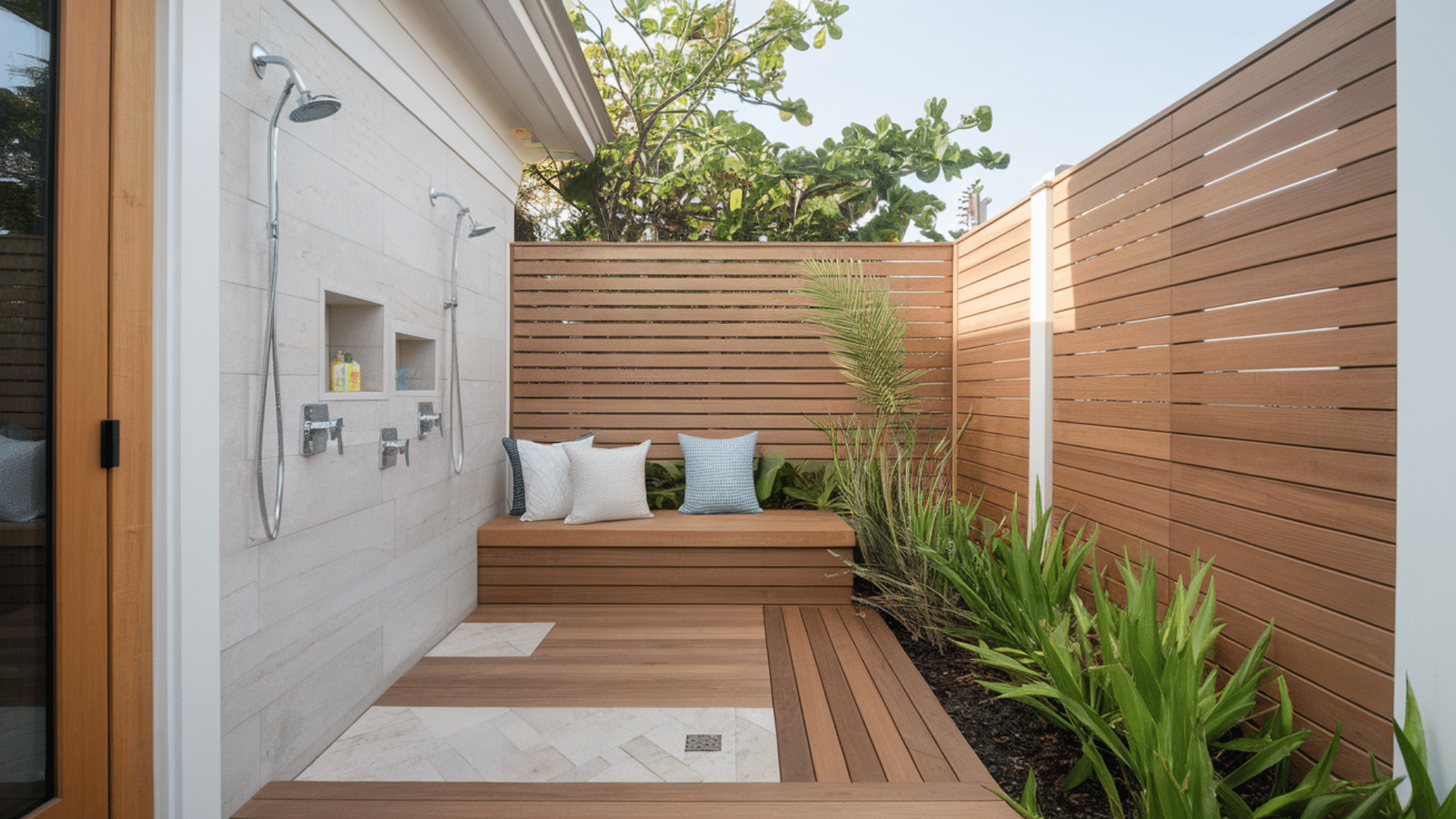
No beach house is complete without a place to rinse off sand before entering.
Outdoor showers have evolved from simple rinse stations to luxurious outdoor bathing experiences. Hot and cold water options make these usable year-round in many climates.
Thoughtful design includes built-in niches for soap and shampoo, plus hooks for towels and swimsuits.
Privacy can be created with slatted walls that allow airflow while blocking sightlines. Drainage should be carefully planned to prevent erosion or wet areas around the foundation.
Many homeowners incorporate benches and changing areas for complete functionality. Materials should be chosen for their ability to handle constant moisture—think teak, stone, or composite decking.
11. Natural Light Emphasis
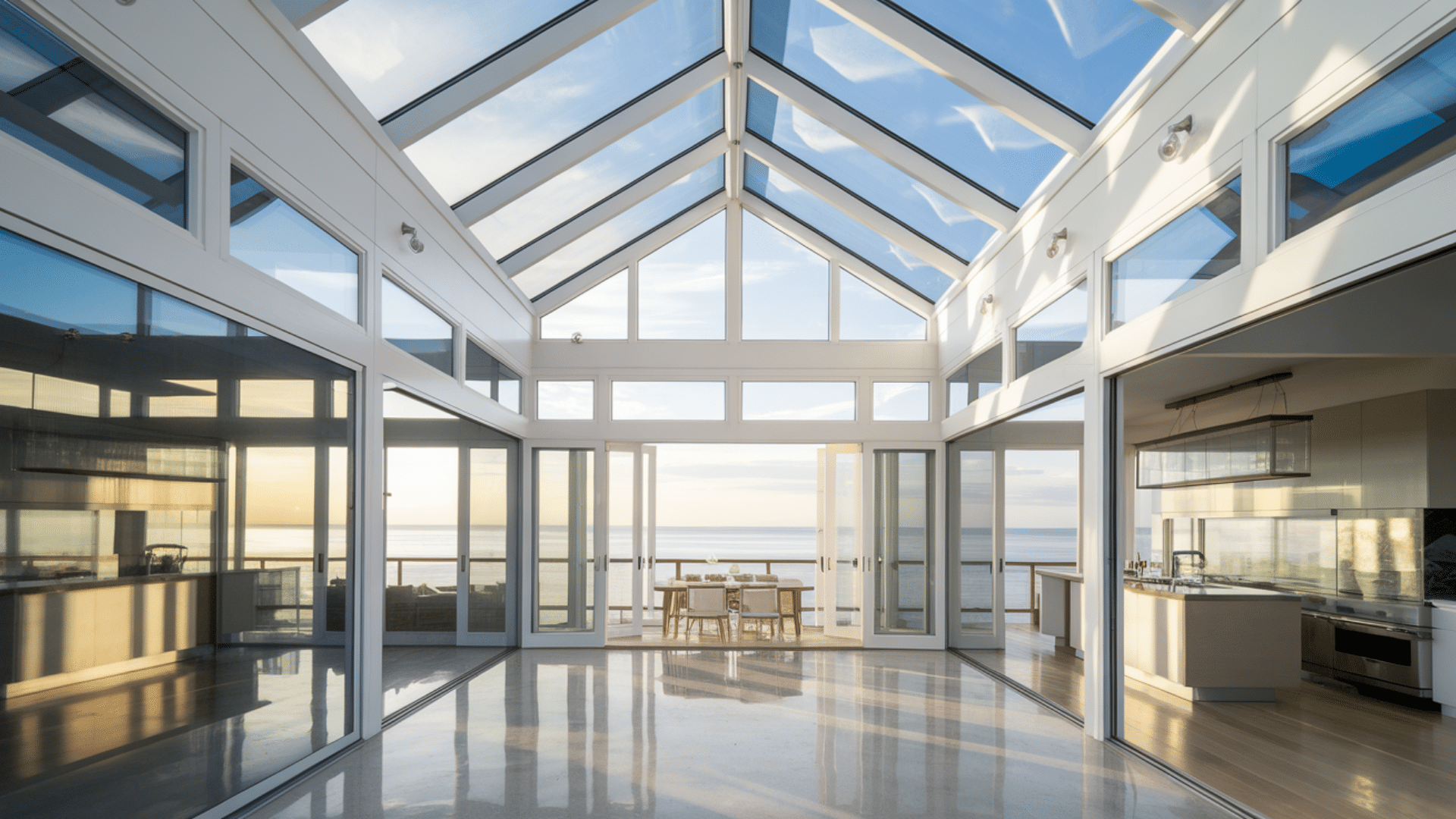
Beyond just windows, modern beach houses employ multiple strategies to maximize daylight.
Skylights bring sunshine into interior spaces that can’t have exterior windows. Light wells carry brightness from upper levels down to lower floors.
Transom windows above doors allow light to flow between rooms while maintaining privacy.
Reflective surfaces like polished floors or glossy backsplashes bounce light deeper into the home. These techniques reduce electricity usage and create a naturally uplifting environment.
Strategic placement of mirrors can boost natural light effects. Even on cloudy days, a well-designed beach house feels bright and connected to the outdoors.
12. Minimalist Décor
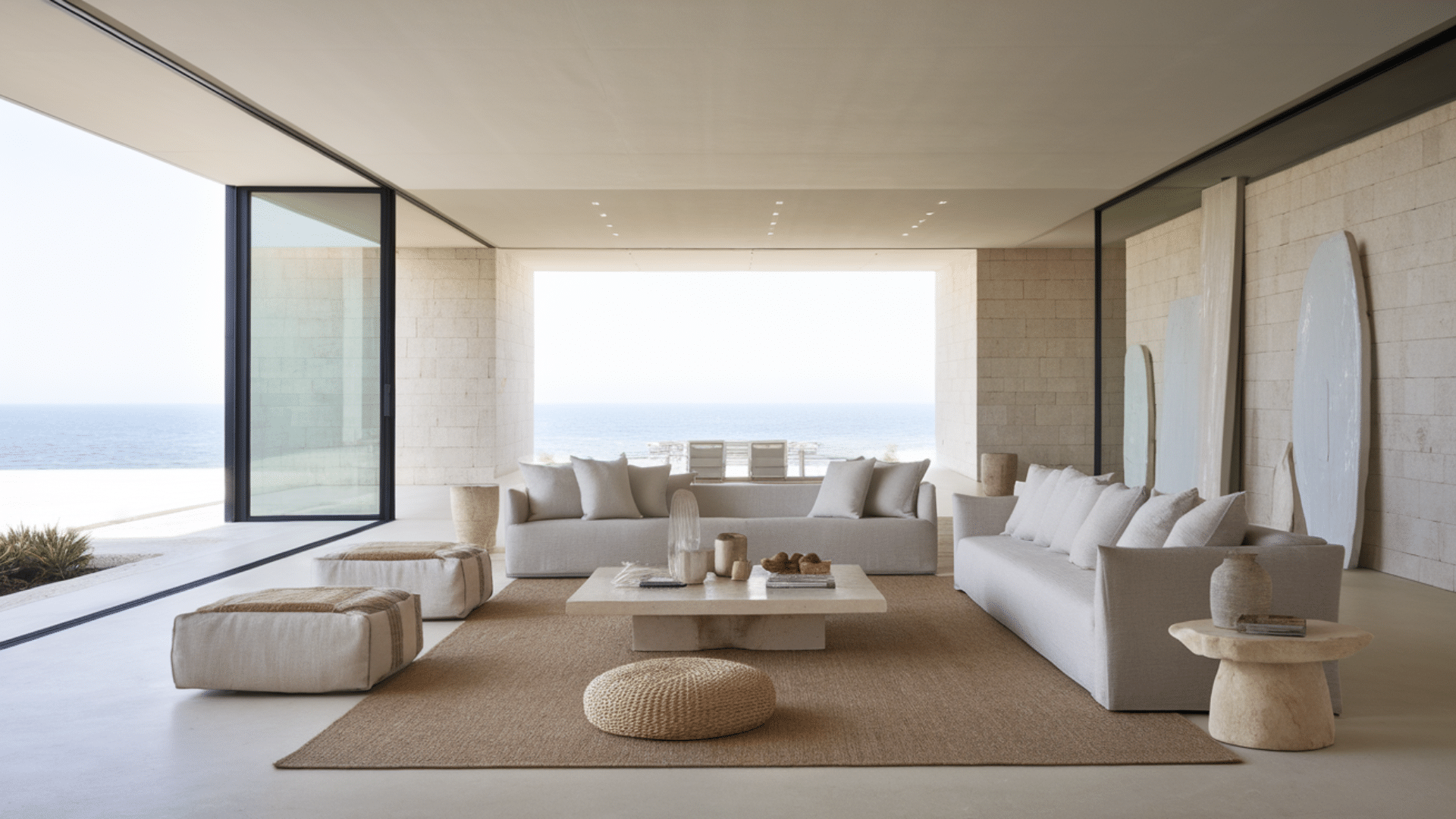
Beach houses benefit from a “less is more” approach to furnishings and decorations. Clean lines and uncluttered surfaces create a sense of calm that complements coastal living.
This doesn’t mean barren—thoughtfully chosen pieces with meaning make bigger impacts than numerous small items.
Quality matters more than quantity in this design approach. Invest in comfortable, durable furniture that invites relaxation.
Let architectural features and views provide the visual interest rather than filling spaces with objects. Choose art and accessories that enhance the coastal mood without falling into cliché “beach themed” territory.
A curated collection of items with personal significance creates a more authentic space than generic décor.
13. Indoor-Outdoor Flow
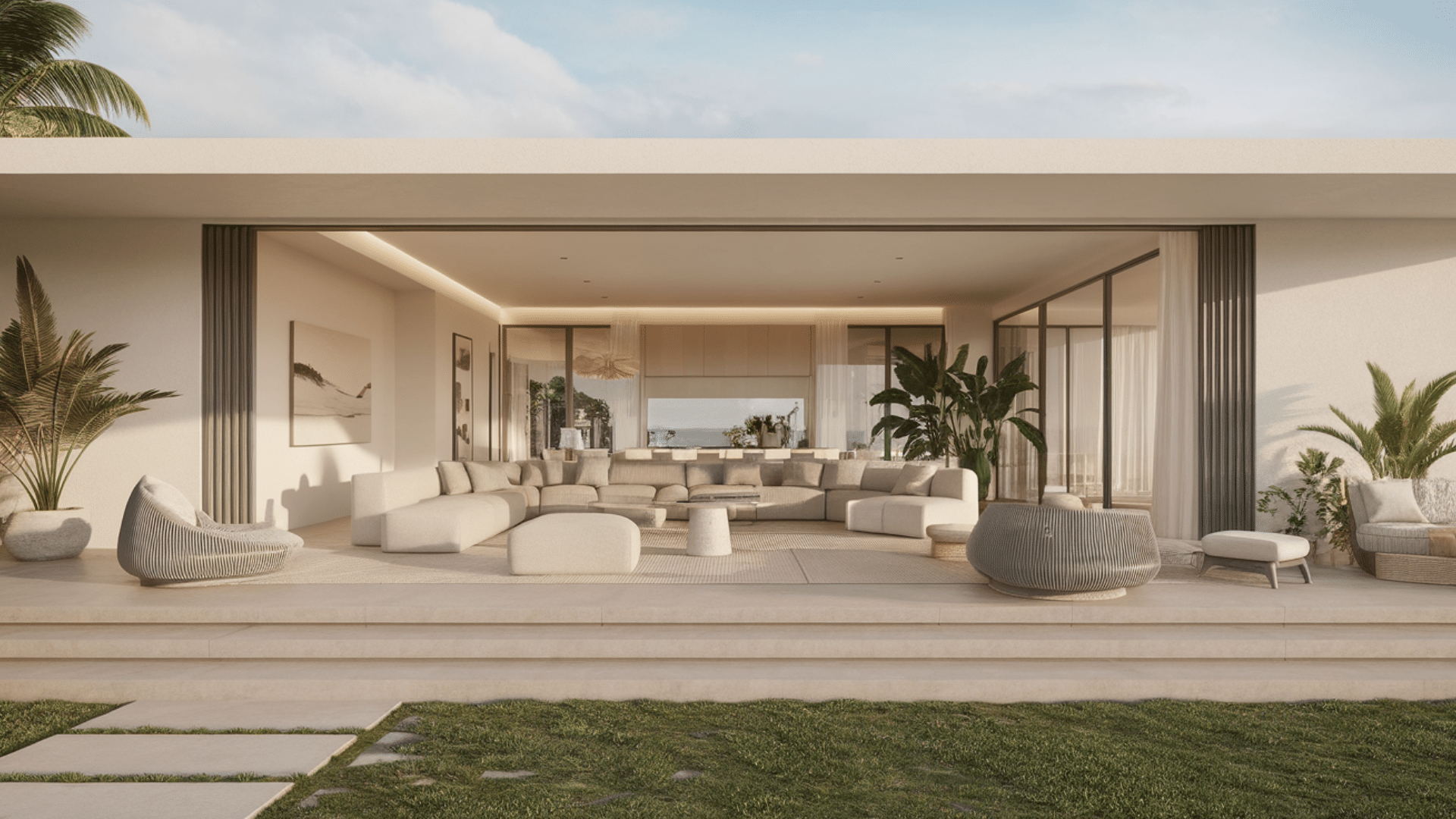
True beach living happens when the boundary between inside and outside becomes blurred. Consistent flooring materials that extend from interior to exterior spaces strengthen this connection.
Pocket doors or folding wall systems can open entire sections of the home to decks or patios. Indoor plants bring nature’s textures inside, while outdoor living rooms with comfortable furniture extend the home’s functional space.
Temperature and light conditions become part of the design equation rather than elements to be completely controlled.
Consider how seasonal changes affect this relationship. Design for the full range of weather conditions your beach location experiences throughout the year.
14. High Ceilings with Exposed Beams
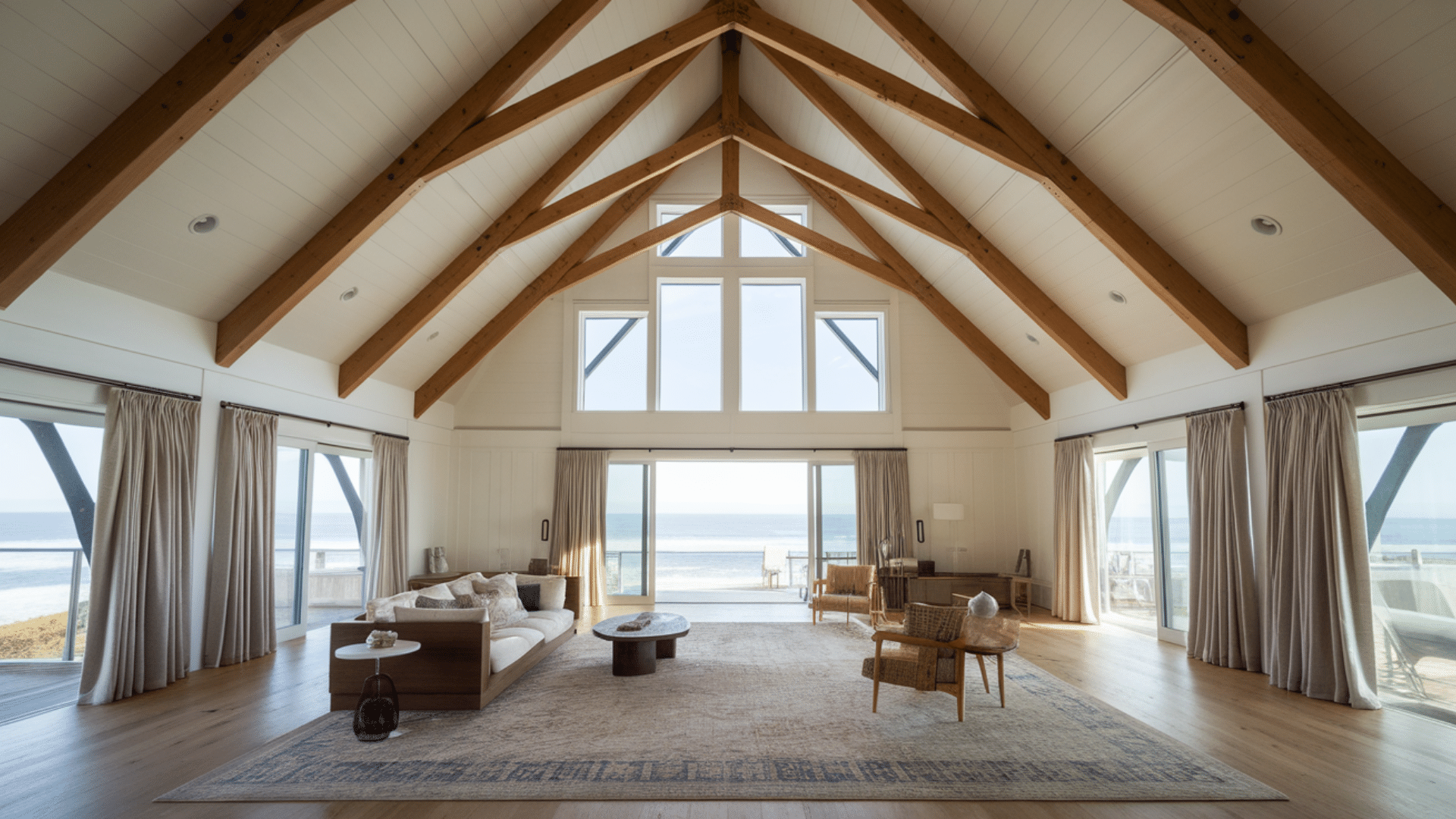
Vertical space creates an airy, expansive feeling that complements coastal environments.
Exposed structural elements add character and visual interest without cluttering the space. These higher ceilings allow for larger windows and better air circulation.
Cathedral designs can follow roof lines for dramatic effect. Wood beams bring natural texture and warmth to white-walled interiors.
The additional volume makes homes feel larger without increasing the floor area. Consider the acoustic properties of these spaces—too much hard surface can create echo.
Strategic placement of soft materials like rugs and curtains helps manage sound in high-ceilinged rooms.
15. Driftwood and Weathered Finishes
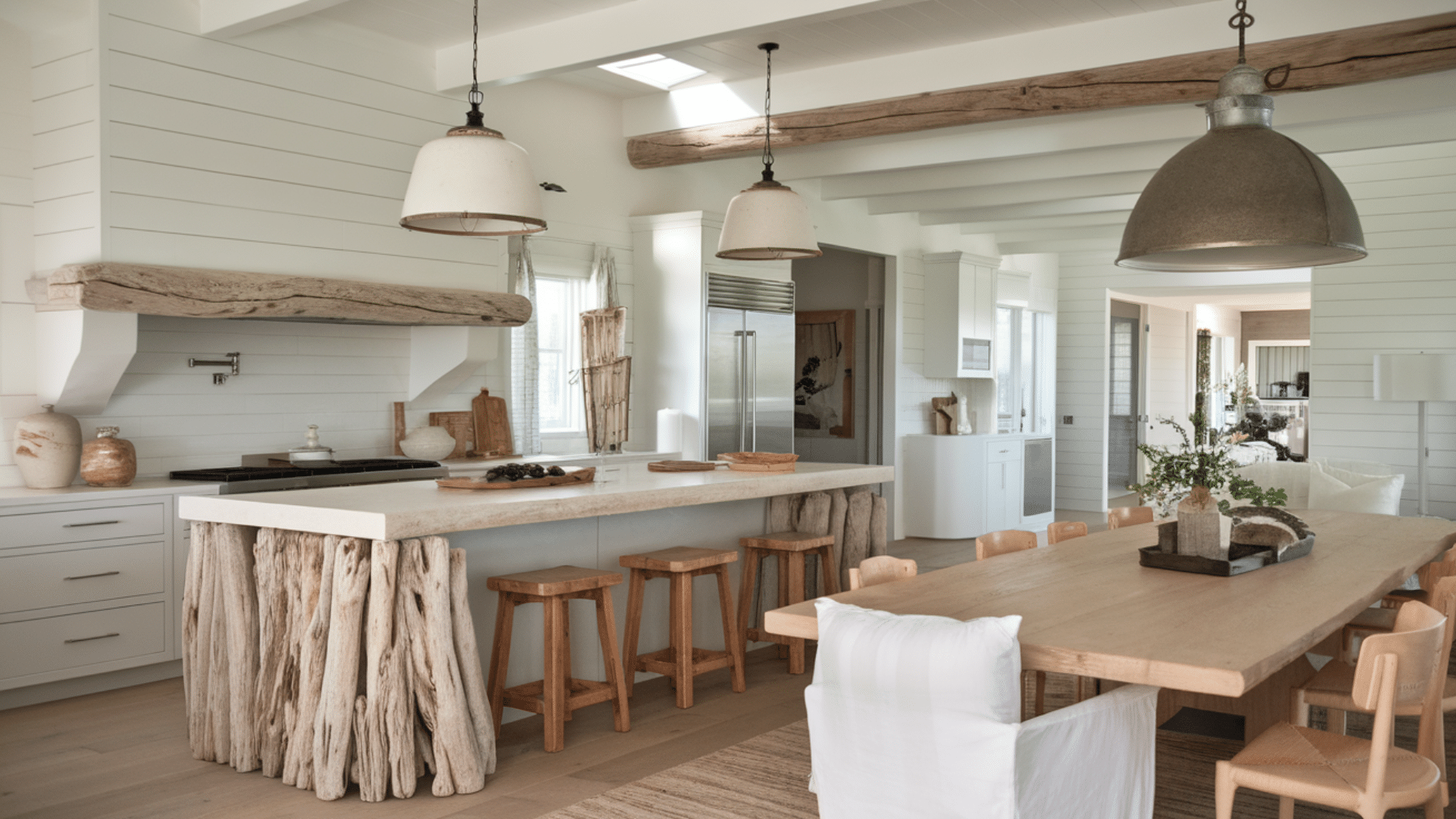
The natural patina of beach-found materials brings authentic coastal character indoors.
Weathered wood surfaces tell a story and connect interiors to the surrounding environment. These aged finishes work particularly well as accents against crisp, modern elements.
Look for responsibly sourced driftwood or manufactured alternatives with similar character.
Weathered metals like zinc or pewter develop beautiful patinas in salt air environments. These materials often improve with age rather than deteriorating.
Incorporate these elements in focal points like mantels, kitchen islands, or statement furniture pieces. A little goes a long way—too much can overwhelm the clean lines of modern design.
16. Stone and Concrete Accents
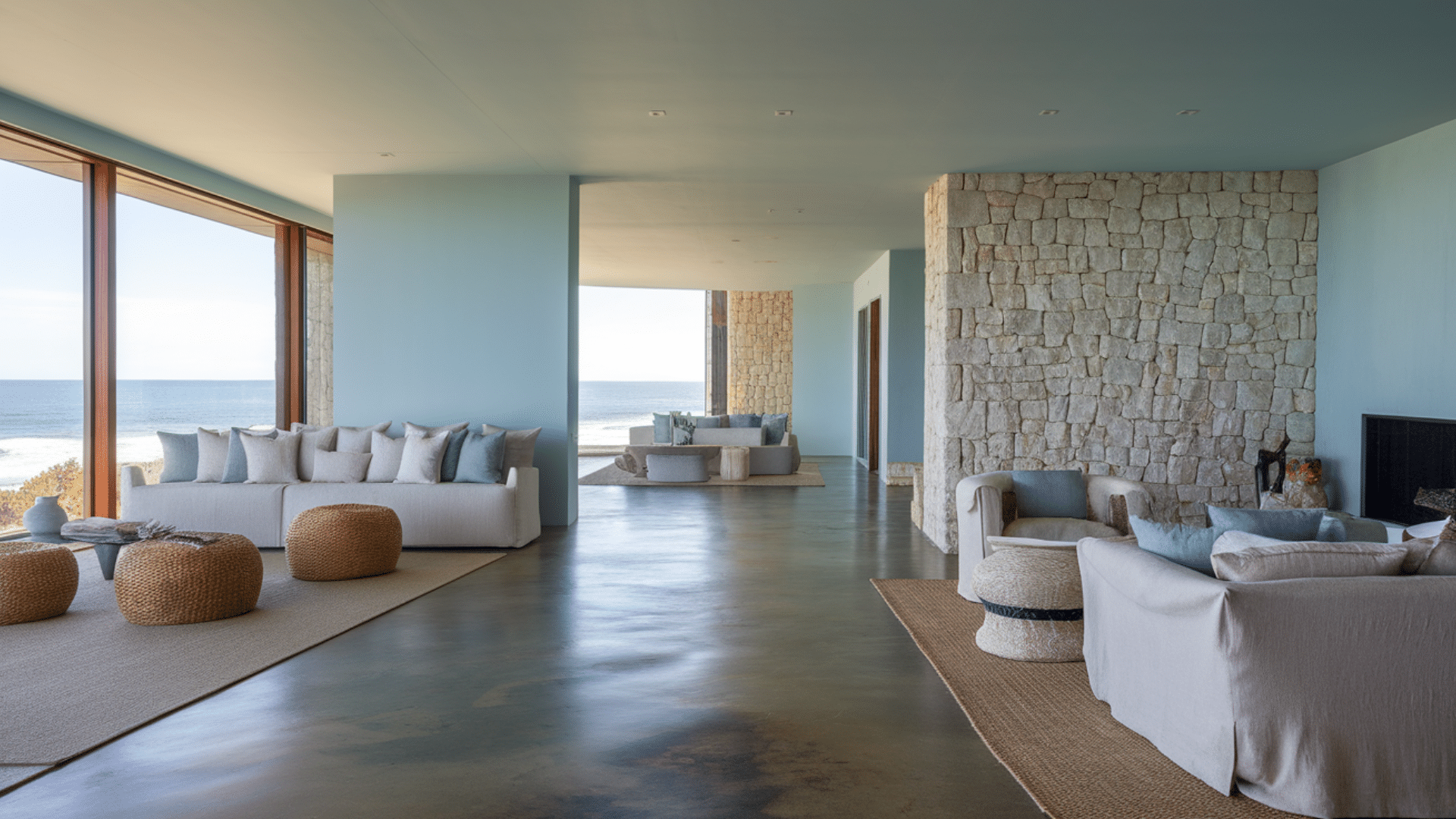
Hard surfaces add necessary contrast to the soft textiles and weathered woods in beach houses.
Polished concrete floors offer durability for sandy feet and low maintenance for busy beach living. Natural stone brings the colors and textures of coastal cliffs indoors.
These materials provide thermal mass that helps regulate temperature fluctuations common in beachfront locations.
Consider local stone when possible for a genuine connection to the specific beach environment. Modern concrete applications can be surprisingly warm and organic.
Look beyond gray for colored concrete options that complement your palette. Remember that larger format stone tiles mean fewer grout lines to clean and maintain.
17. Natural Fiber Rugs and Linens
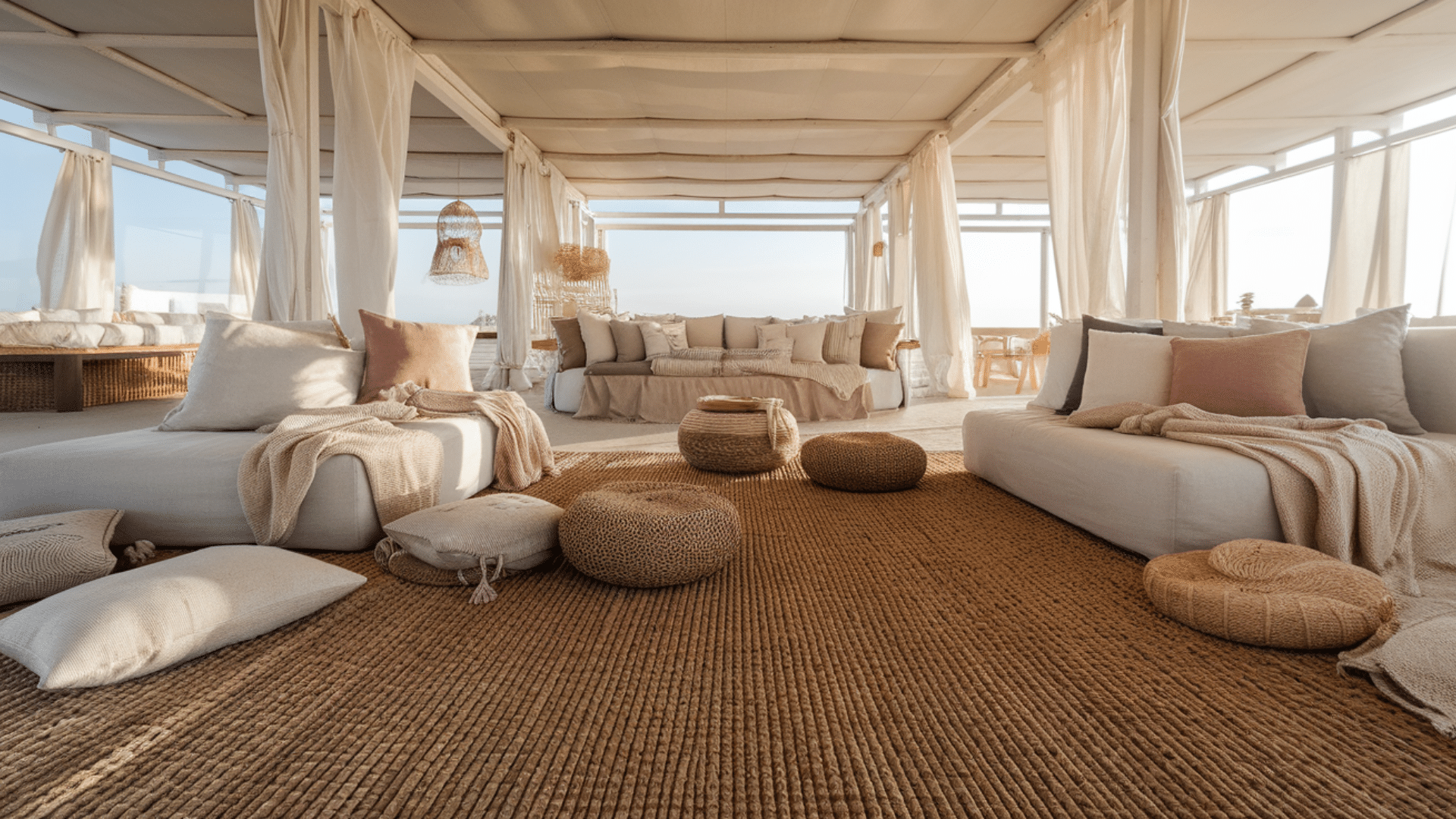
Textiles in beach houses should be as relaxed and breathable as the lifestyle. Sisal, jute, and seagrass rugs handle sand well and add organic texture underfoot.
Linen upholstery stays cool in summer heat and develops a lovely lived-in quality over time. Cotton throws and cushions provide comfort without fussiness.
These natural materials perform well in humid environments and bring tactile interest to minimalist spaces. They also help manage acoustics in open floor plans with many hard surfaces.
Choose indoor-outdoor fabrics for pieces that might encounter wet swimsuits or weather exposure.
The technology behind these materials has improved dramatically, offering soft, attractive options that still resist fading and mildew.
18. Glass and Metal Fixtures
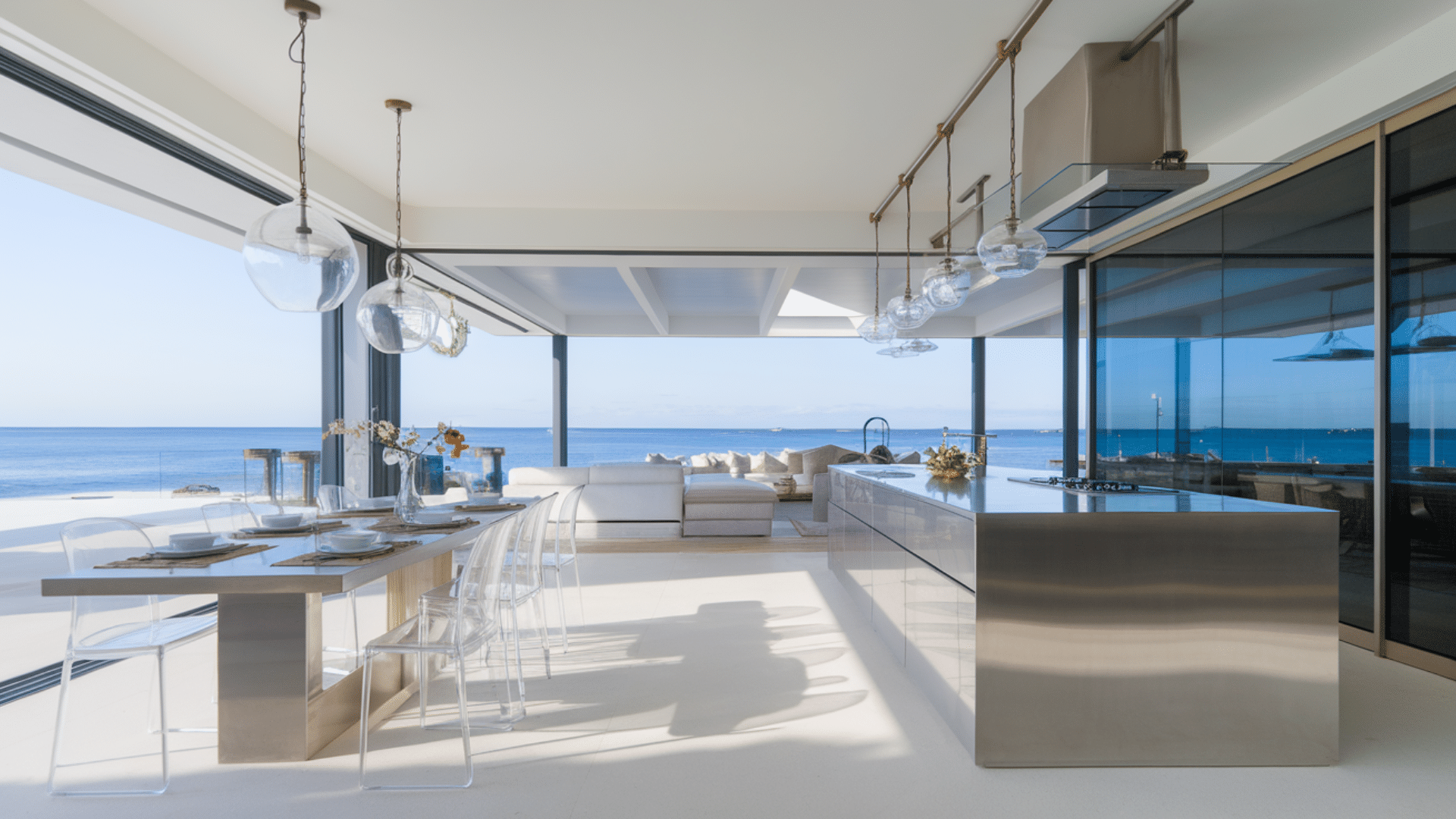
Fixtures and hardware in coastal environments must withstand unique challenges. Marine-grade stainless steel or bronze hardware resists corrosion from salt spray.
Glass light fixtures stay beautiful even with exposure to humidity and don’t trap salt particles.
These materials complement the clean design of modern beach architecture. Simple glass pendants allow views to remain unobstructed.
Metal finishes can be chosen to either stand out as design features or blend quietly into the background.
Consider how these elements catch and reflect light throughout the day. The best choices enhance natural light characteristics rather than competing with them.
19. Statement Lighting
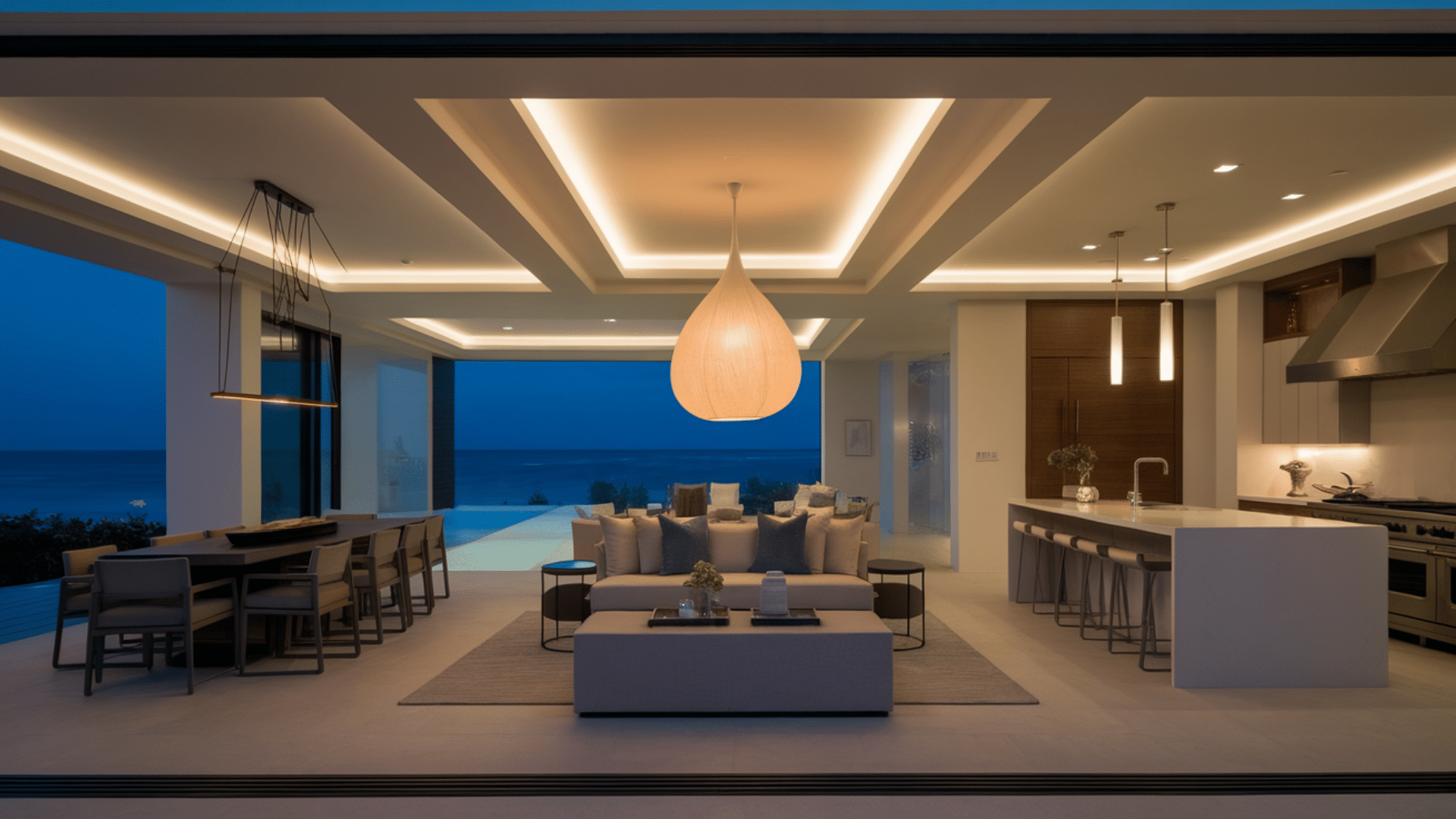
Strategic lighting creates atmosphere and defines spaces within open floor plans.
Oversized pendants can anchor dining areas or stairwells without blocking views. Sculptural fixtures become artwork themselves, adding personality to minimalist interiors.
Layer different light sources for flexibility—recessed lighting for general illumination, pendants for task areas, and accent lights for special features.
Outdoor lighting extends living spaces into the evening hours and highlights architectural elements.
Look for dark-sky compliant fixtures for exterior use that won’t contribute to light pollution. This preserves star-viewing opportunities and protects local wildlife that can be disrupted by excessive artificial light.
20. Energy-Efficient Windows and Insulation
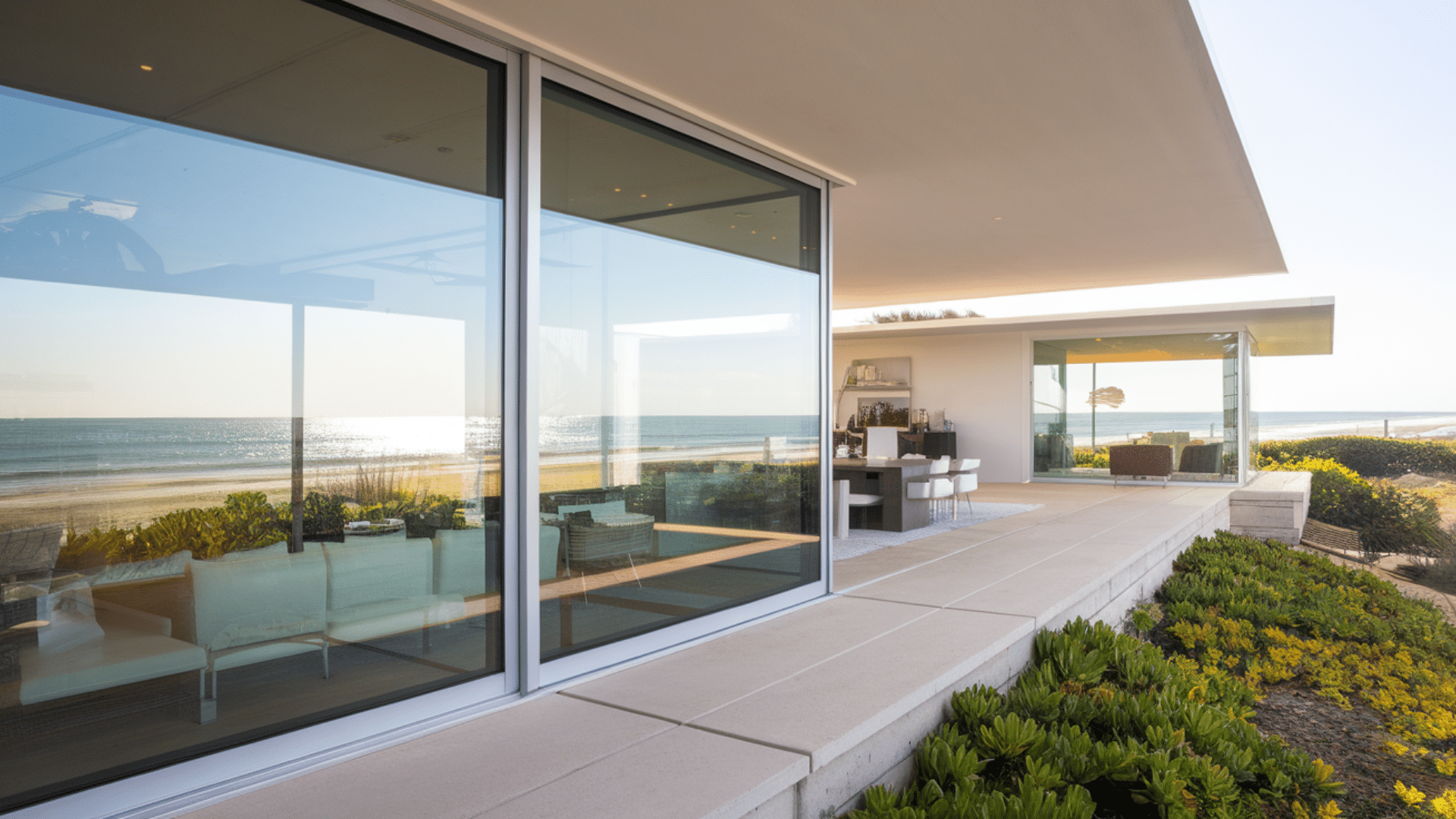
Beach locations often experience temperature extremes that challenge comfort and energy efficiency.
Double or triple-glazed windows with low-E coatings manage solar gain while preserving views. Proper insulation in walls and roofs keeps cool air in during summer months.
Many modern beach homes achieve near net-zero energy usage through thoughtful design. Window placement should respond to the specific solar orientation of your site.
South-facing glass (in the northern hemisphere) requires different treatment than north-facing windows.
Consider the whole building envelope when planning efficiency measures. The best results come from integrated approaches rather than single solutions.
21. Solar Panels and Rainwater Collection
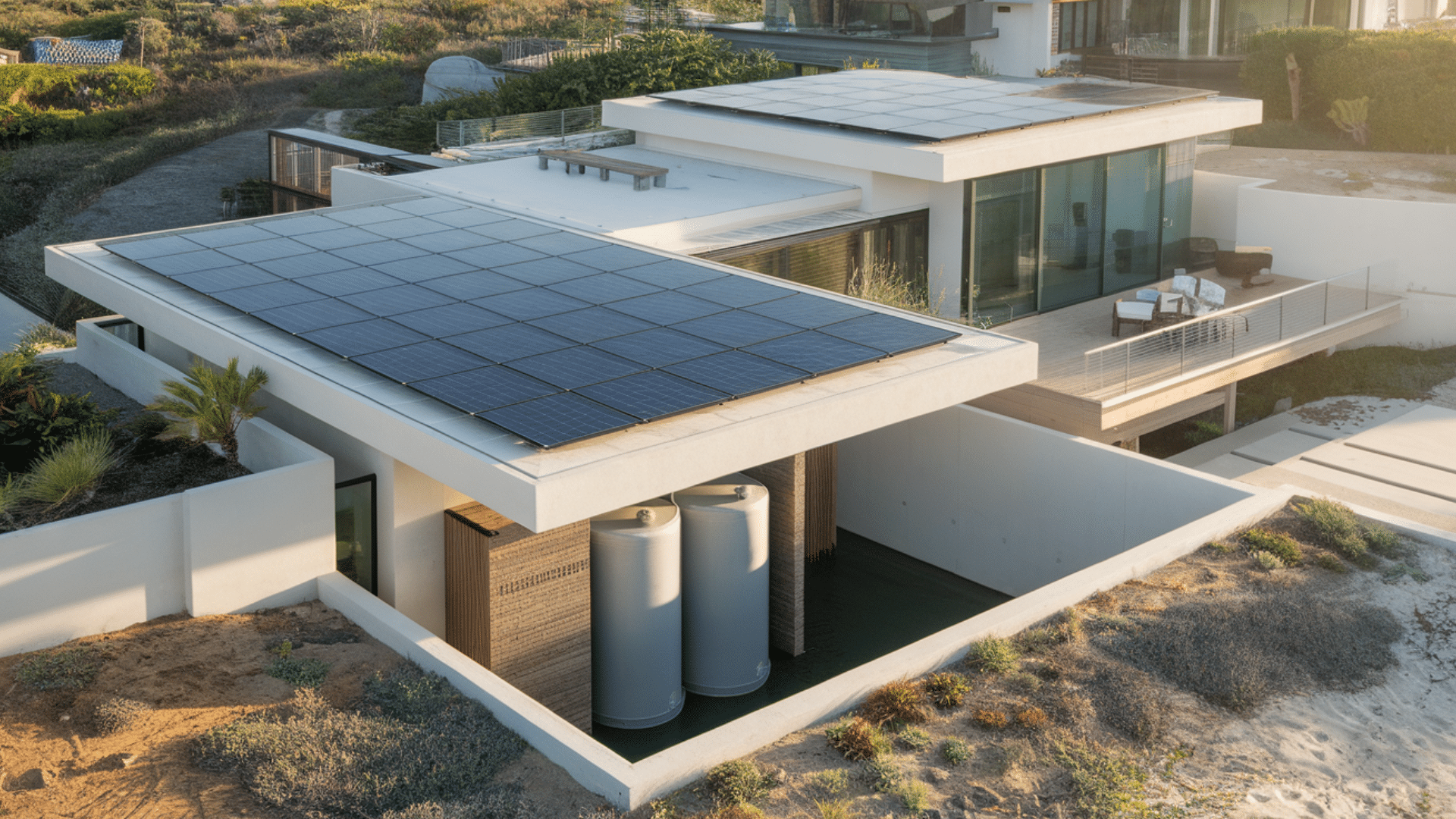
Beach locations typically offer abundant natural resources that can be harnessed sustainably.
Solar panels take advantage of unobstructed sun exposure common in coastal areas. Modern systems can be integrated into rooflines for a sleek appearance.
Rainwater collection systems provide irrigation water during dry periods. Storage tanks can be designed as landscape features or hidden beneath decks. These systems reduce dependency on municipal water and lower environmental impact.
Battery storage options now make solar power practical even for full-time beach residences. Local incentives often help offset installation costs for these sustainable systems.
22. Outdoor Kitchen and Fire Pits
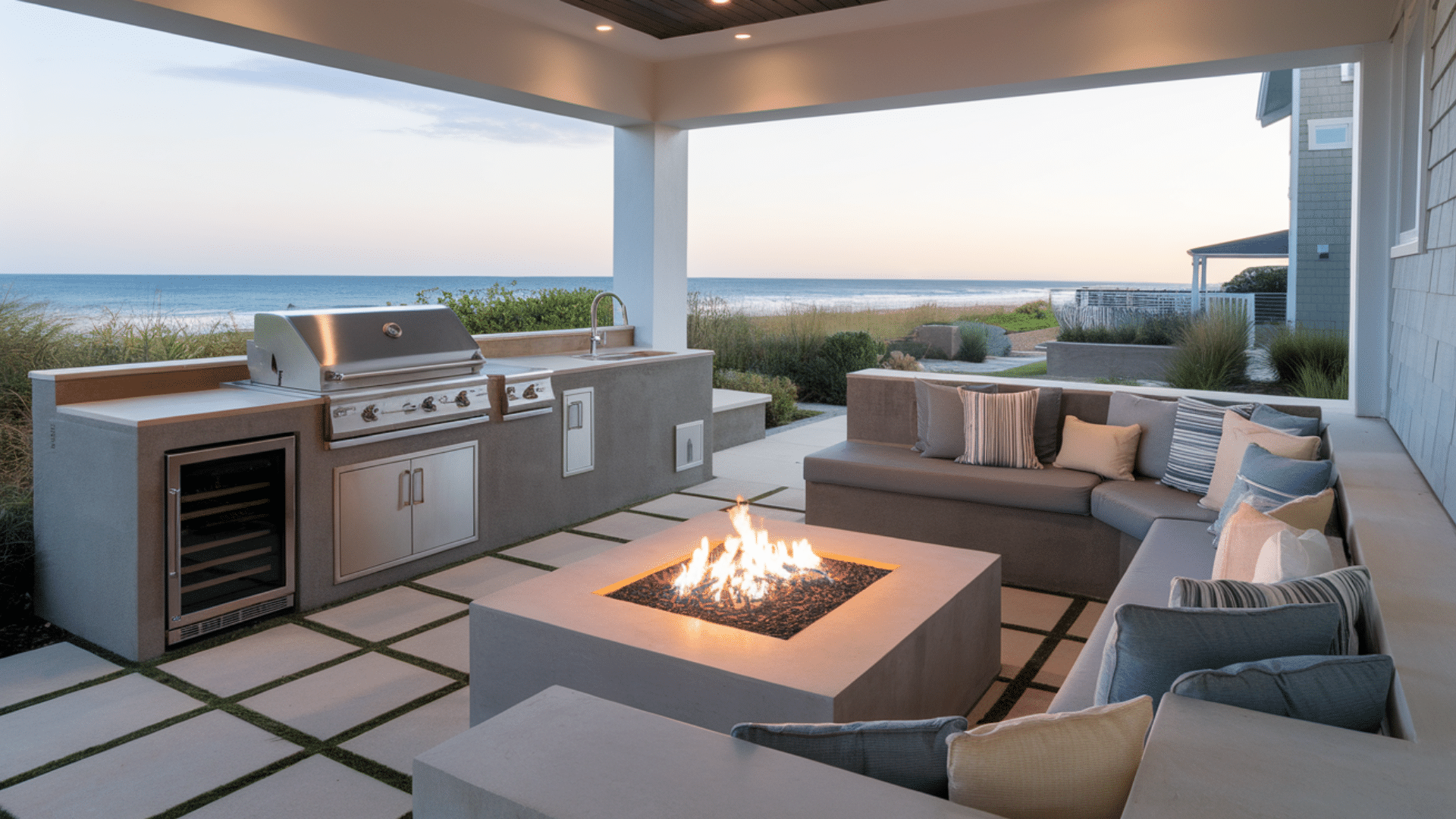
Cooking and gathering spaces outdoors extend living areas and keep heat and odors outside during warm months. Modern outdoor kitchens range from simple grilling stations to complete cooking suites with refrigeration and sinks.
Fire pits create gathering spots for evening conversations and extend outdoor season into cooler months. Weather-resistant materials like concrete, stone, and marine-grade stainless steel ensure longevity.
Position these features to capture views while considering prevailing winds for smoke management. Many designs incorporate seating walls or built-in benches to maximize space efficiency.
Check local regulations regarding open flames, especially in drought-prone coastal areas. Gas fire features often provide more flexibility with less maintenance than wood-burning options.
23. Native Landscaping
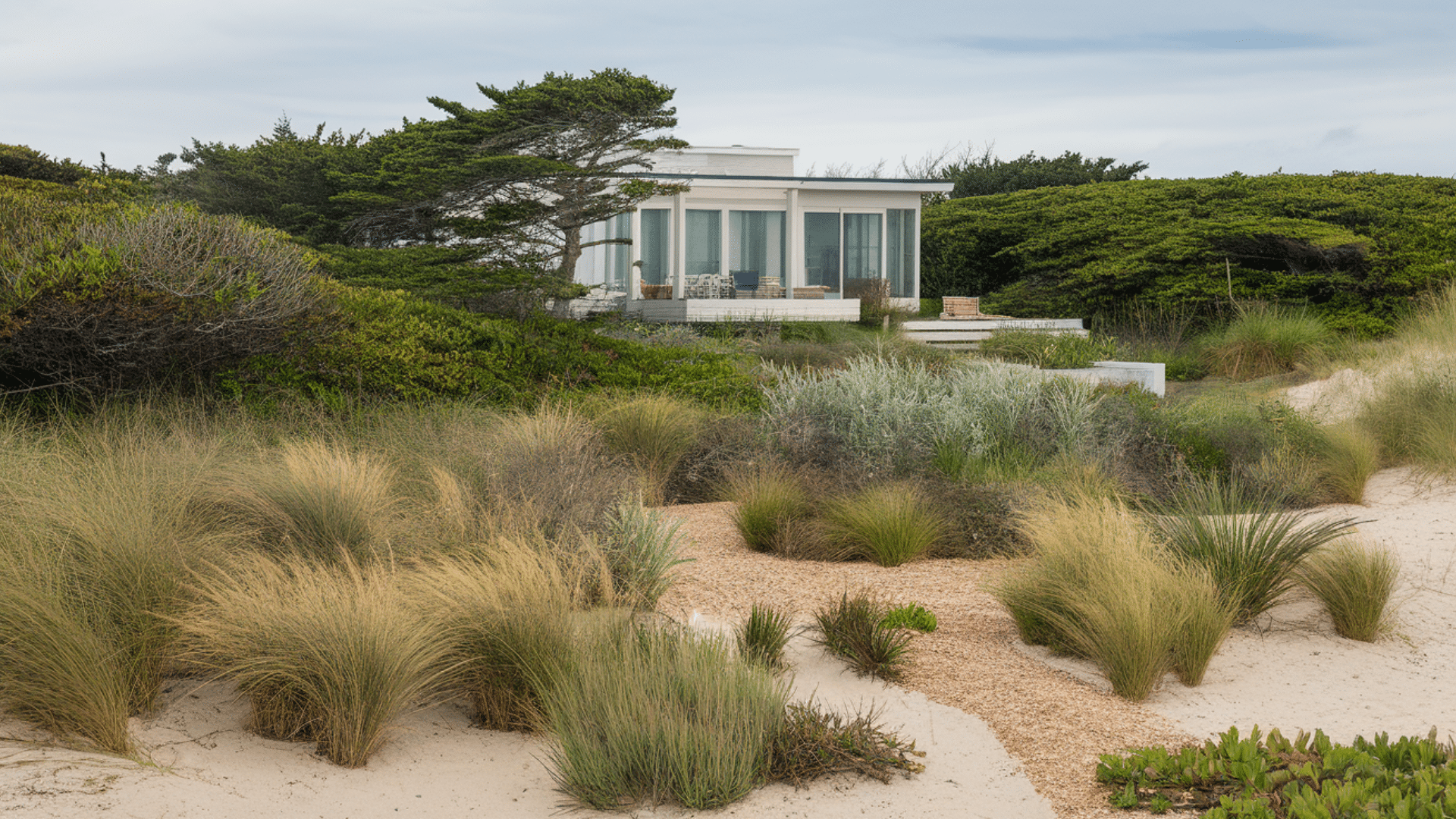
The surrounding landscape should connect a beach house to its natural environment.
Native coastal plants require minimal water and maintenance once established. They also provide crucial habitat for local wildlife and pollinators.
Plants adapted to local conditions resist diseases without chemical treatments.
Consider natural screening for privacy rather than fences where possible. Group plants according to water needs to maximize irrigation efficiency.
Incorporate dune restoration principles if your property connects directly to beaches. These approaches prevent erosion while preserving the natural coastal ecosystem.
24. Smart Storage Solutions
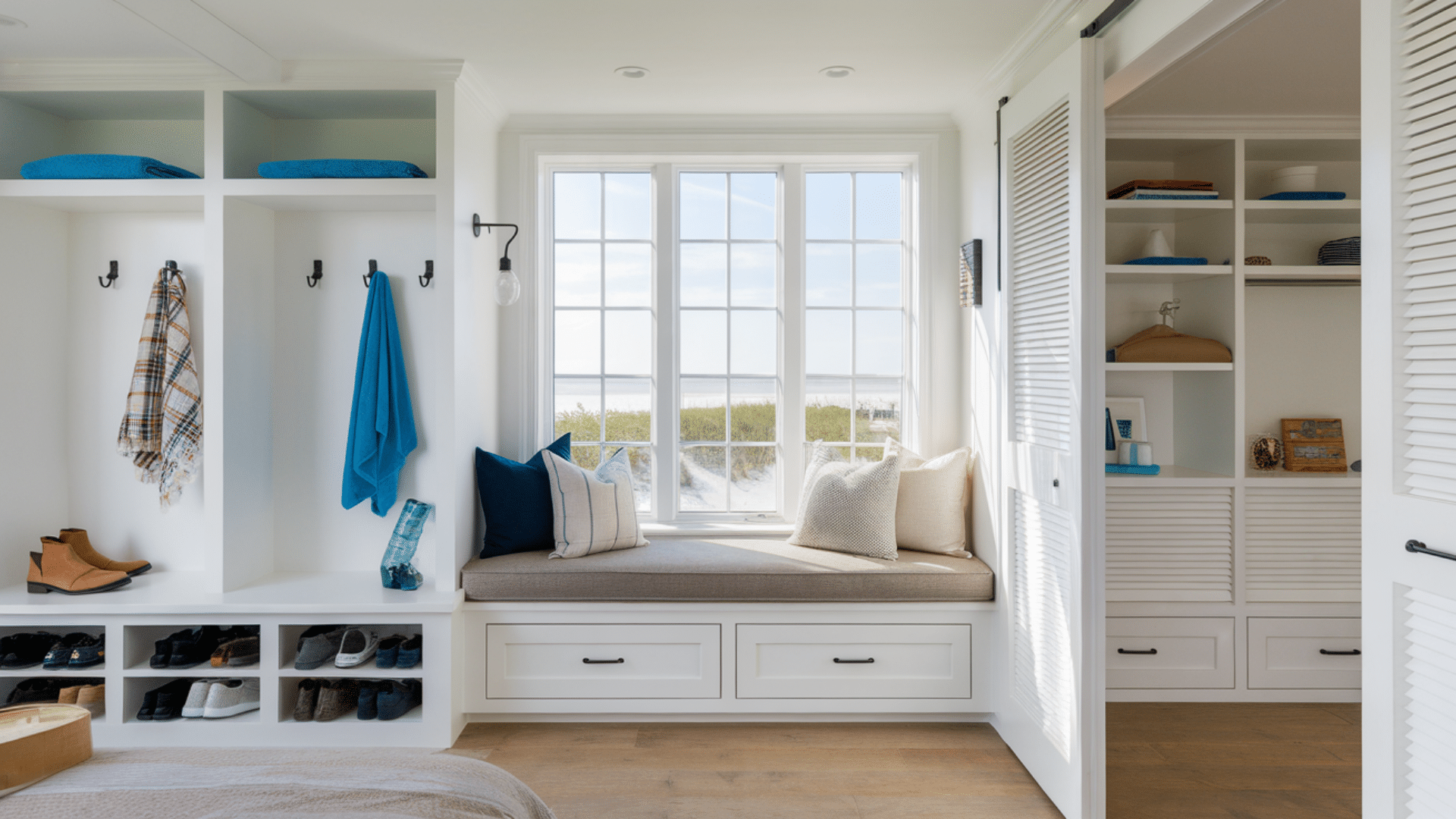
Beach activities generate gear that needs thoughtful storage planning. Built-in cabinets and window seats with hidden storage keep spaces uncluttered.
Mudroom designs with specific places for sandy shoes, wet towels, and beach toys make daily transitions smoother.
Under-bed storage works well in guest rooms that need flexibility. Wall-mounted options keep floors clear for easy cleaning of sand.
The best solutions anticipate how you’ll actually use the space rather than forcing you to adapt to rigid systems. Consider humidity when designing closets and storage areas. Ventilation prevents mustiness in rarely-used spaces.
Open shelving in some areas allows air circulation while keeping items visible and accessible.
Conclusion
Building or renovating a modern beach house gives you the chance to create something truly special. It’s about finding that sweet spot where beauty meets function.
I’ve shared these elements because they’ve proven themselves time and again in coastal settings.
They work together to create homes that feel connected to their surroundings while standing up to challenging conditions.
Your beach house should reflect your personal style and how you like to live by the water.
Maybe you’re all about entertaining large groups, or perhaps you value quiet spaces for reflection and relaxation. Either way, these design principles can flex to suit your needs.
Remember that the best beach houses evolve over time. Start with good bones—the architectural elements that are hardest to change—and let your interior details develop as you spend time in the space.
What’s your must-have beach house feature? I’m curious about what element matters most to you in a beach house design.
Is it the connection to outdoors? Smart storage for beach gear? Or maybe those million-dollar views through floor-to-ceiling windows?
Share your thoughts below—I’d love to hear what makes a beach house perfect in your eyes!

